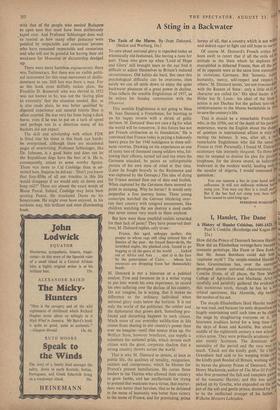I, Hamlet, The Dane hi How did the Prince of
Denmark become Hamlet! ill How did an Elizabethan revenge-hero become romantic prototype, like Faust or Don Juan, s`t tit that Mr. James Burnham could dub biro 141 'capitalist myth'? The simple-minded Hamlet,‘" E Saxo Grammaticus has, over the centur'cr' developed almost universal characteristics. , Conklin (from, of all places, the New Modc;41 College of Agriculture and Mechanic Arts) 113i w carefully and painfully gathered the evidence this monstrous myth, though he has let a f'„ critical specimens, like Akenside, slip betOe''
the meshes of his net. st
The simple Elizabethans liked Hamlet becalls eb` he was mad, and because his antic disposition hugely entertaining until such time as he cleare.` at the stage by slaughtering everyone on it. fb,I1 histrionic tradition lasted for a long time—' the days of Kean and Kemble. But about 111, middle of the eighteenth century, a new school critics arose. They were primarily academic-- also mostly Scotsmen. The dominant seri"c; mentality of the period and the race was 1,9 "1 : much. 'Check not the kindly gush,' Sir Chart 111 Grandison had said to his weeping bride---°., et the kindly gush flooded all Britain, washing wit" ; di its waves the gloomy Prince of Denmark. It 10„ Henry Mackenzie, author of The Man Of Feelifi. to who first presented the full and complete pict,,11re b1, lh of the romantic Hamlet; and this was quicl'iyl tit picked up by Goethe, who expanded on the 511e 6( I ject of the soft and gentle prince, doomed by f 3.0 to be the ineffectual avenger of his father, Wilhelm Meisters Lehrjahre. Goethe put more than a little of himself into his picture of Hamlet, who resembles not only Wilhelm Meister but Faust. Coleridge found an even deeper and more agonising Doppelganger In the hero of this Shakespearean revenge-tragedy. 'This is a satire on himself,' remarked one of the audience to Crabb-Robinson at Coleridge's 1S12 lectures. 'No, it is an elegy,' replied Robinson. Coleridge had fashioned an image of Hamlet that was profoundly personal—and had little in com- mon with the character originally delineated by Shakespeare. But such was the power of Coleridge's imagination and so deep was the implication of his own personality with that of the Hamlet he had created, with some hints from Shakespeare, that in despite of all the scholars and experts who have tried to kill it with learned treatises on the Elizabethan background, the Coleridgean Hamlet, whose ruling passion is thought not action, still holds the field. Dr. Conklin, who is an earnest pupil of E. E. Stoll, obviously does not like this, but all his patient scholarship will hardly change it.
THOMAS HOGAN































 Previous page
Previous page